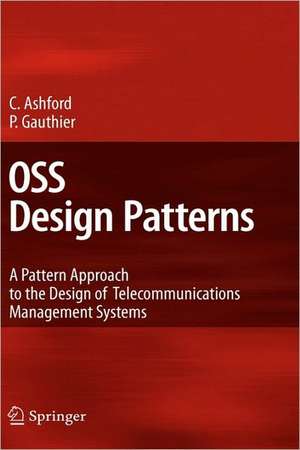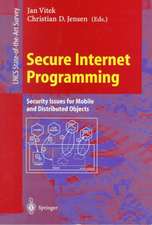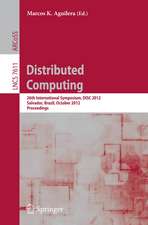OSS Design Patterns: A Pattern Approach to the Design of Telecommunications Management Systems
Autor Colin Ashford, Pierre Gauthieren Limba Engleză Hardback – 8 oct 2009
| Toate formatele și edițiile | Preț | Express |
|---|---|---|
| Paperback (1) | 326.13 lei 6-8 săpt. | |
| Springer Berlin, Heidelberg – 9 oct 2014 | 326.13 lei 6-8 săpt. | |
| Hardback (1) | 332.24 lei 6-8 săpt. | |
| Springer Berlin, Heidelberg – 8 oct 2009 | 332.24 lei 6-8 săpt. |
Preț: 332.24 lei
Preț vechi: 415.30 lei
-20% Nou
Puncte Express: 498
Preț estimativ în valută:
63.58€ • 69.04$ • 53.41£
63.58€ • 69.04$ • 53.41£
Carte tipărită la comandă
Livrare economică 23 aprilie-07 mai
Preluare comenzi: 021 569.72.76
Specificații
ISBN-13: 9783642013959
ISBN-10: 3642013953
Pagini: 200
Ilustrații: XV, 151 p.
Dimensiuni: 155 x 235 x 15 mm
Greutate: 0.41 kg
Ediția:2009
Editura: Springer Berlin, Heidelberg
Colecția Springer
Locul publicării:Berlin, Heidelberg, Germany
ISBN-10: 3642013953
Pagini: 200
Ilustrații: XV, 151 p.
Dimensiuni: 155 x 235 x 15 mm
Greutate: 0.41 kg
Ediția:2009
Editura: Springer Berlin, Heidelberg
Colecția Springer
Locul publicării:Berlin, Heidelberg, Germany
Public țintă
Professional/practitionerDescriere
The management of telecommunications networks and services is one of the most challenging of software endeavors—partly because of the size and the distributed nature of networks; partly because of the convergence of communications techno- gies; but mainly because of sheer complexity and diversity of networks and services. The TM Forum s Solutions Frameworks (NGOSS) help address these challenges by providing a framework for the development of management applications—those software applications that provide the building blocks for management solutions. The members of the TM Forum have elaborated many parts of NGOSS to make it practical—including in the area of information modeling, process analysis, and c- tract de?nition. This book further elaborates NGOSS by examining the challenging area of interface design. One of the costs of deploying a new service is the cost of integrating all the necessary applications into an effective software solution to manage the service. This cost has been dubbed the “integration tax” and can turn out to be ?ve times the capital cost of procuring the management software in the ?rst place. From their long experience of the design and standardization of management applications, the authors have extracted a core set of design patterns for the dev- opment of effective and consistent interfaces to management applications. Adopting these patterns across the industry could reduce the learning curve for software - velopers and allow service providers and systems integrators to rapidly and reliably deploy management solutions and thereby markedly reduce the integration tax.
Cuprins
Part 1 - Overview of OSS Development: Introduction.- The Telecommunications-management Landscape.- Managing Telecommunications Networks.- Implementing OSS Client Systems.- Design Patterns.- Goals of the Book.- Part 2 - OSS Design Patterns: Introduction.- JEE as an OSS Implementation Architecture.- OSS Architectural Patterns.- Managed-entity-value Basic Patterns.- Managed-entity Selection Patterns.- Managed-entity Update Patterns.- Managed-Entity Life-Cycle Patterns.- Event-reporting Patterns.- Extension Patterns.- Distributed Location Patterns.
Textul de pe ultima copertă
This book advocates a pattern-based approach to the design of interfaces to Operations Support Systems (OSSs) to reduce the cost of delivering telecommunications management solutions.
OSSs are the large servers that host the OSS applications that manage telecommunications services. Developing solutions to manage telecommunications services entails integrating the functionality of a number of OSS applications through their integration interfaces. Owing to the complexity, size, and distributed nature of telecommunications networks and services, application designers have necessarily turned to the latest software technologies to implement OSS applications. This has led to a proliferation of interface styles and underlying information models that makes systems integration both expensive and error prone.
Rather than proposing yet another technology-specific interface specification and information model, this book makes the case for an agreement across the OSS community on a core set of technology-neutral OSS Design Patterns. The book details over a dozen OSS-specific design patterns—many based on proven distributed-systems patterns—that will help in the design of consistent interfaces to OSS applications. Each pattern is accompanied by examples of its implementation in two software technologies: Java Platform, Enterprise Edition and Java Message Service.
OSS application designers will find that the book makes a compelling case for adopting these architectural and programming patterns to future-proof their designs. It is a valuable contribution to the growing ecosystem of best practices, common code, and proven designs for OSS applications and their interfaces.
OSSs are the large servers that host the OSS applications that manage telecommunications services. Developing solutions to manage telecommunications services entails integrating the functionality of a number of OSS applications through their integration interfaces. Owing to the complexity, size, and distributed nature of telecommunications networks and services, application designers have necessarily turned to the latest software technologies to implement OSS applications. This has led to a proliferation of interface styles and underlying information models that makes systems integration both expensive and error prone.
Rather than proposing yet another technology-specific interface specification and information model, this book makes the case for an agreement across the OSS community on a core set of technology-neutral OSS Design Patterns. The book details over a dozen OSS-specific design patterns—many based on proven distributed-systems patterns—that will help in the design of consistent interfaces to OSS applications. Each pattern is accompanied by examples of its implementation in two software technologies: Java Platform, Enterprise Edition and Java Message Service.
OSS application designers will find that the book makes a compelling case for adopting these architectural and programming patterns to future-proof their designs. It is a valuable contribution to the growing ecosystem of best practices, common code, and proven designs for OSS applications and their interfaces.
Caracteristici
Guides to a standardization by a higher level of architectural agreement - design patterns
Provides an enduring architectural-level direction that will guide developers
Distillation of many years experience
Provides an enduring architectural-level direction that will guide developers
Distillation of many years experience






























